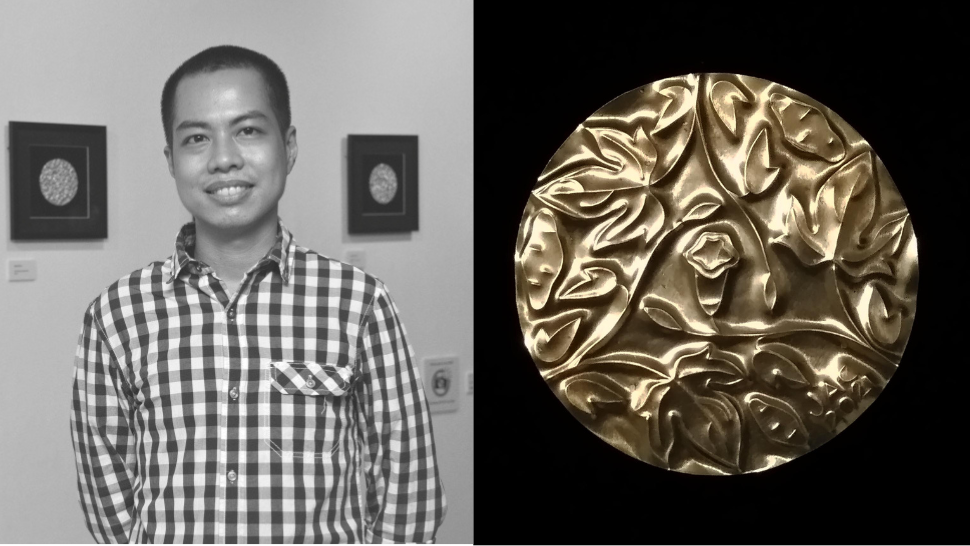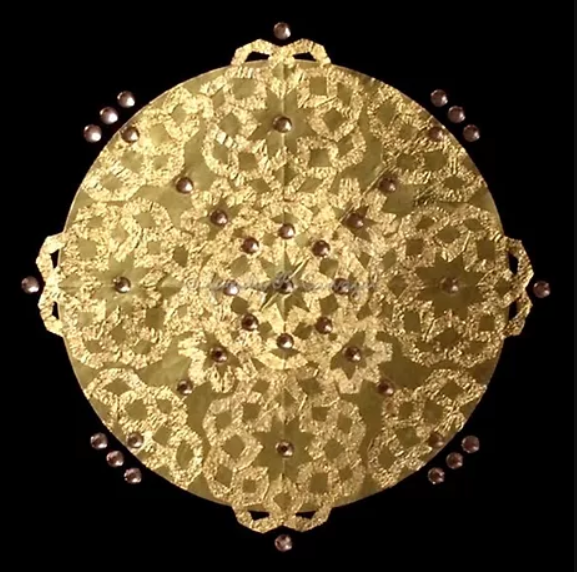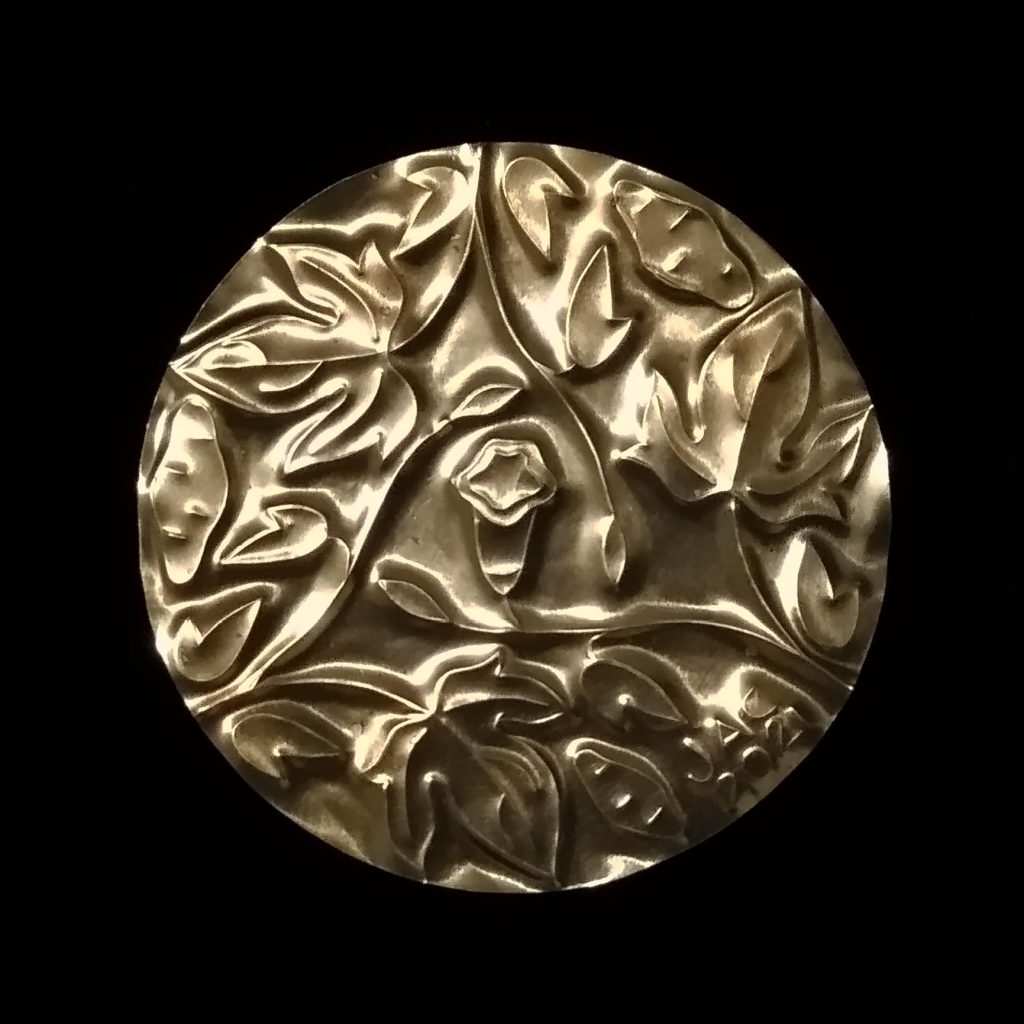By Bryle B. Suralta
It’s a centuries-old practice that endures to this day.

When we look at religious icons during our visits to church, we are reminded of the glory and skill of Filipino craftsmanship in the littlest of ways. Look closely at the heads of the saints, figures, and santo niños and we can see crowns and halos of embossed metal and gold. This, in fact, is an art form in itself, and one that dates back to as far as the fourth century in various cultures.
Repoussé transcends the decorative and elevates itself to the spiritual with its meticulous design elements. It is an ancient technique of embellishing and engraving metals by pushing hammers and different tools to create powerful imagery, referencing the culture inherent to the pieces.
In the context of ancient Philippines, our Visayan ancestors were famous for repoussé. What others would call primitive actually has parallels in other indigenous, religious, and colonial beliefs and traditions in Europe and the far east. The term is derived from the French word “pousser,” which means “to push forward.” It peaked in popularity in Europe during the 16th, 17th, and 18th centuries.
A Chinese gold stem cup with repoussé decoration, dating back to the 7th to 9th century.

Repoussé has been long used to adorn the iconography of Christian art in the Philippines, as well. These works are a byproduct of Spanish Colonial tradition. We can see examples of this in the form of halos and crowns on our own sacramentals and religious symbols.

Jandy Carvajal, who is an assistant professor of Fine Arts at the University of the Philippines Baguio, has made the art of repoussé his life’s work. His current exhibition at the National Commission for Culture and the Arts Gallery entitled Ang Ating Mga Kayamanan sa Ating Bakuran inspects repoussé in a post-modern world with everyday objects and subject matters. Curated by Alain Zedrick Camiling, the show reassesses subjectivities and complexities brought about by the pandemic and the relationship between collection and production.
In 1991, Carvajal first explored repoussé by using aluminum sheets from milk cans. He would shelve the practice for years, opting to focus on school. Carvajal would do a photomanipulation of his works two decades later and from there, he pursued and rediscovered the technique on a much deeper level.
“My newfound inspiration for this were pre-Hispanic Philippine gold artifacts that I was privileged to see during a series of museum visits,” he claims in an explanatory report. “They were a feast for the eyes.” He also thinks back to a collection at the Ayala Museum called Gold of Ancestors, which he credits as a showcase that further escalated his interest in repoussé. Here, the exhibit detailed and showcased artifacts from pre-colonial Visayas whose peoples were described in 16th century accounts as those “who were adorned in gold.”
Detail of the repoussé on the “Crown of the Andes,” which was made for the image of the Virgin of the Immaculate Conception venerated in Popayán Cathedral in the former Spanish viceroyalty of New Granada (present-day Colombia). Dating back to the 17th century, this crown is considered one of the most important examples of repoussé work during Spanish Colonial America.

These were what he calls “ancient artists” who were gifted in the practice. In turn, they manipulated these precious metals and wound up creating meaning entirely their own.
The repoussé technique had also been magnified by the Spanish Colonial period, which then added a particular mythos to our sacramentals. Carvajal’s work draws from his own religious background, evidenced in his previous exhibits at the Victor Oteyza Community Art Space (VOCAS) in Baguio and the Cultural Center of the Philippines in Pasay back in the early 2010s. Carvajal also drew from old folk concepts like botanicals and traditional tattoo motifs. He makes use of old reliable aluminum, as well as copper and brass for his pieces.
“Araw (Sun)” (2014) by Jandy Carvajal, Foil, Paper, and Acrylic Gems on Paper. This piece was presented at VOCAS.

“Ex Voto 1” (2015) by Jandy Carvajal, Aluminum. The artist said of this exhibit: “Ex votos are objects that represent the gist of devotees’ prayers, traditionally, either in gratitude or in supplication.” Carvajal, however, communicated expressions of human concerns, traversing the gray area between wants and fulfillment.

“Crown of Creation” (2018) by Jandy Carvajal, Brass. This was part of the artist’s juried exhibit, Difference and Deference, at the School of Oriental & African Studies, University of London. The center specializes in the study of Asia, Africa, and the Middle East.

For his latest exhibit, Carvajal toys around with the notions of irony in treasures in the form of ethnic values and ecological possibilities. “The inedible gold ironically underscores that good is more valuable and this juxtaposition emphasizes that hunger is equally a threat amidst the current pandemic,” he noted.
Carvajal was also inspired by the community pantries and gardens grown during the early portion of our health crisis. He ended up carving common vegetables, like kangkong, kamote, and the like, for this exhibit. Carvajal took roughly two months to finish all of the 13 pieces.
“Kalabasa” (2021) by Jandy Carvajal, Gold-Plated Brass. The assistant professor bridges the gap between social and cultural ecologies and ideas of opulence, consumption, and preservation.

In places like Pampanga, the repoussé technique is alive and well. But Carvajal is looking to amplify the practice even more, starting with Baguio, where he teaches, and in Manila and abroad. Repoussé, in general, can be done even with the common foil we have at home, just as long as we are careful enough not to puncture them. Pencils, popsicle sticks, and more can be used as tools, too. All we have to do is take from our time, history, and way of life, much like Carvajal has.
The artist is one of the select few who sheds light on the beauty of the form, always looking for newer ways of expression and meaning.
“Thirty years since I first created my first repoussé pieces, I continue to appreciate my two main sources of inspiration. I am grateful for our kababayans of centuries past for their artistic legacy, which serve as a pivotal catalyst for my continued art practice,” he said.
Ang Ating Mga Yaman Sa Bakuran will be on display at the NCCA Gallery in Intramuros, Manila until July 31, 2022.
Source: https://www.esquiremag.ph/culture/books-and-art/art-of-repousse-with-jandy-carvajal-a2765-20220711-lfrm
